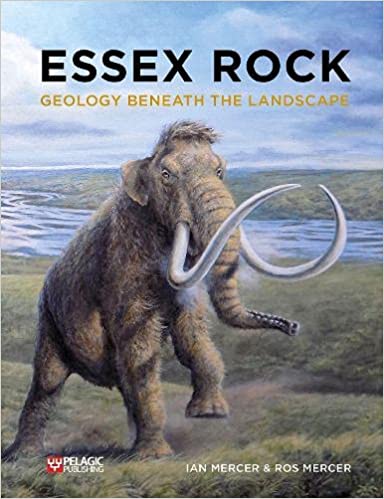Essex Rock: Geology beneath the Landscape
by Ian Mercer and Ros Mercer

To be fair, Essex has never been famed or well-regarded for its geology, at least not by me. I know it has its locations – Walton-on-the-Naze springs to mind – but not a lot else. However, this guide is set to change all that. Full colour photographs and illustrations (on virtually every page), with 416 pages of excellent text, with particularly good sections on the London Clay and Red Crag, it is as good as it gets. It is worth owning for its own sake, even if you are not going to, or are living in, Essex.
In that way, it is aspirational. As one reviewer (Dr Chris Gibson of the British Naturalists Association) said, this book is:
Essential for anyone with an interest in Essex and soft-rock landscapes, this book is also for the person who just thinks they might be interested. After a few minutes you surely will be.”
Or, as the online marketing for the book explains:
We are all living in an ice age, an ongoing event that has hugely affected Essex over the last 3 million years. Yet this county was born more than 500 million years ago. Our story begins when the land we know as Essex was part of a large continent close to the South Pole, tracing the geological processes that continue to shape the countryside around us. The form of the land, boulders on village greens, road cuttings, cliffs, stones in church walls – they can all bring geology to light in unexpected and fascinating ways.”
The ice age we have been living through (which, in fact, has been going on for the last three million years) has massively affected Essex. However, the geology of Essex actually covers a time span of more than 500 million years. As the quotation above explains, Essex (as was) was part of a large continent close to the South Pole before slowly traversing the world through tropical seas to end up where it is today. This amazing geological journey is explored by the book, along with the geological processes that continue to shape Essex’s countryside, including those boulders on village greens.
That is, the chapters cover significant periods of unique geological time (rather than locations as such), to allow the reader to then understand specific areas of the county. However, the book is clearly aimed at a general readership with no scientific background. In fact, the chapters start with the fundamentals before moving on to cover the more detailed research that has been undertaken in the county. But always in an engaging style and always with great pictures and a wonderful layout.
Ian Mercer worked for the British Geological Survey and Geological Museum (before it was absorbed by the Natural History Museum in London) for 25 years and was Director of Education for the Gemmological Association of Great Britain for nearly two decades. Ros Mercer was a geology and physics teacher for more than 20 years. Both have also been leaders for the Essex Rock and Mineral Society for many years, UK national advisors for U3A Geology, and officers for GeoEssex – the county geoconservation steering group.
In 2020, they were both awarded the Halstead Medal by the Geologists’ Association for their achievements as ‘ambassadors in the promotion of geology, contributing to education at all levels’. Ian Mercer is the author of several books on related subjects.
I thoroughly recommend this book. It is one of the best I have reviewed in recent years.
Essex Rock: Geology beneath the Landscape, by Ian Mercer and Ros Mercer, Pelagic Publishing (2022), 416 pages (paperback), ISBN-13: 978-1784272791.